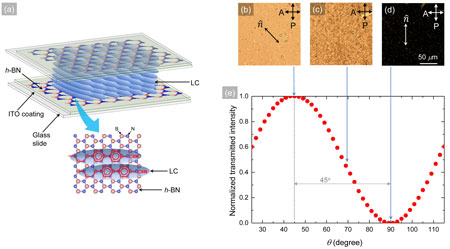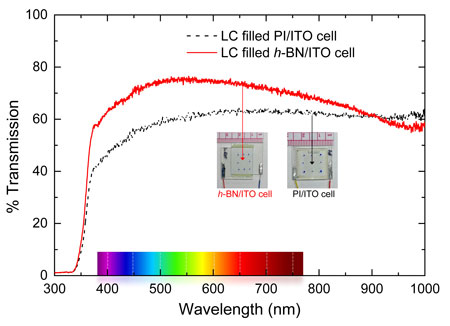| Jan 09, 2019 | |
Scientists use 2D h-BN nanosheets as the planar-alignment agent in a liquid crystal device to improve its optical transmission |
|
| (Nanowerk Spotlight) Liquid crystals (LCs) are optically anisotropic materials, and they are widely used in electro-optical display technology, known as liquid crystal displays (LCDs). Understanding the alignment phenomena of a nematic LC on a surface remains an important area of research, as the alignment process determines the LC’s molecular orientation and conformation – which influence the LC’s optical and electro-optical characteristics in LCDs. | |
| The planar-alignment layers are utilized to create an easy axis of the nematic director of the LC in the LCD. The conventional planar-alignment layer is a rubbed polyimide (PI)-coated surface. On the unidirectionally rubbed PI alignment substrate, the LC molecules align with alkyl side chains along the rubbing direction, creating a uniform planar director profile on the substrate. | |
| However, the conventional rubbed PI alignment process has some disadvantages. The occurrence of fiber dust during the rubbing process of the PI contaminates the LC. Uneven rubbing creates a wide distribution of pre-tilt angles of the LC—which causes a non-uniform brightness in the LCD panel. | |
| The PI alignment layers can inject free ion impurities into the LC. Therefore, studying various LC-substrate interactions, and then, developing alternate LC alignment methods (e.g., oblique SiO evaporation, microgroove grating surface fabrication, photoalignment technology, etc.) is an important research direction for optical display applications. | |
| Associate Professor Rajratan Basu and his student Midshipman Lukas Atwood in the Department of Physics at the United States Naval Academy report an interesting phenomenon of two-dimensional (2D) hexagonal boron nitride (h-BN)-induced planar-alignment of a nematic LC and the subsequent optical and electro-optical effects. | |
| They report their findings in the January 7 issue of Optics Express ("Two-dimensional hexagonal boron nitride nanosheet as the planar-alignment agent in a liquid crystal-based electro-optic device"). This work was supported by the Office of Naval Research. | |
 |
|
| Figure 1: (a) A schematic representation of the h-BN-based liquid crystal cell containing a layer of ITO and an h-BN film on each glass slide. Below the cell, the alignment of nematic LC molecules (ellipsoids) on 2D h-BN (honeycomb structure) is illustrated. The epitaxial interaction between the LC and the h-BN lattice is schematically shown by matching the LC’s benzene rings on the h-BN-honeycomb structure. (b), (c), and (d) Micrographs of the bright, intermediate, and dark states, respectively, under the crossed polarized optical microscope of the h-BN-based LC cell filled with LC E7. (e) Normalized transmitted intensity as a function of θ, the angle between the average LC director in the cell and the analyzer. The white bar in micrograph-(f) presents 50 µm. (Image: United States Naval Academy) (click on image to enlarge) | |
| “The sp2 conjugated 2D boron nitride nanosheet forms a honeycomb structure of alternating boron and nitrogen atoms with a lattice spacing of 1.44 Å. This 2D h-BN is an insulator, which has a very high structural, thermal, and chemical stability,” Basu explains. “In the LC, the C-C bond length in the hexagonal benzene rings is 1.40 Å. Therefore, the hexagon of the benzene ring and the hexagon in the h-BN lattice have almost the same size. This nano-architectural symmetry between the hexagons in both the species causes the benzene rings of the LC coherently align on the hexagonal lattice of h-BN. This spontaneous epitaxial alignment mechanism of the LC on the hexagonal lattice is the fundamental principle in our experiment for using the 2D h-BN as the planar-alignment agent in this electro-optic LC device.” | |
| “This h-BN-based LC cell shows the typical electro-optical effect when an electric field is applied via ITO electrodes,” Basu continues. “The dielectric measurement across this h-BN-based electro-optic cell shows a standard Fréedericksz transition of the LC, confirming that the 2D h-BN, as the planar-alignment agent, supplies adequate anchoring energy – which can be overcome by the Fréedericksz threshold voltage.” | |
| Finally, Basu and Atwood show that the h-BN-based LC cell exhibits more optical transparency than the commercial PI-based LC cell. | |
 |
|
| Figure 2: Optical transmission as a function wavelength for the LC-filled PI/ITO cell and the LC-filled h-BN/ITO listed in the legend. The visible wavelength range is shown in the x-axis. The inset pictures show the two cells. (Image: United States Naval Academy) (click on image to enlarge) | |
| Basu and Atwood note that in the commercial LC cell, the total thickness of the two rubbed planar-aligning PI layers is about 120 nm. On the other hand, the thickness of a 2D h-BN film is around 0.3 nm. Replacing both the PI alignment layers with the 2D h-BN on both sides decreases this effective thickness to less than 1 nm – which leads to the potential to increase the optical transmission over a broad spectral range in this LC-based electro-optic device. | |
|
Provided by the United States Naval Academy as a Nanowerk exclusive
|
|
|
Become a Spotlight guest author! Join our large and growing group of guest contributors. Have you just published a scientific paper or have other exciting developments to share with the nanotechnology community? Here is how to publish on nanowerk.com. |
|
